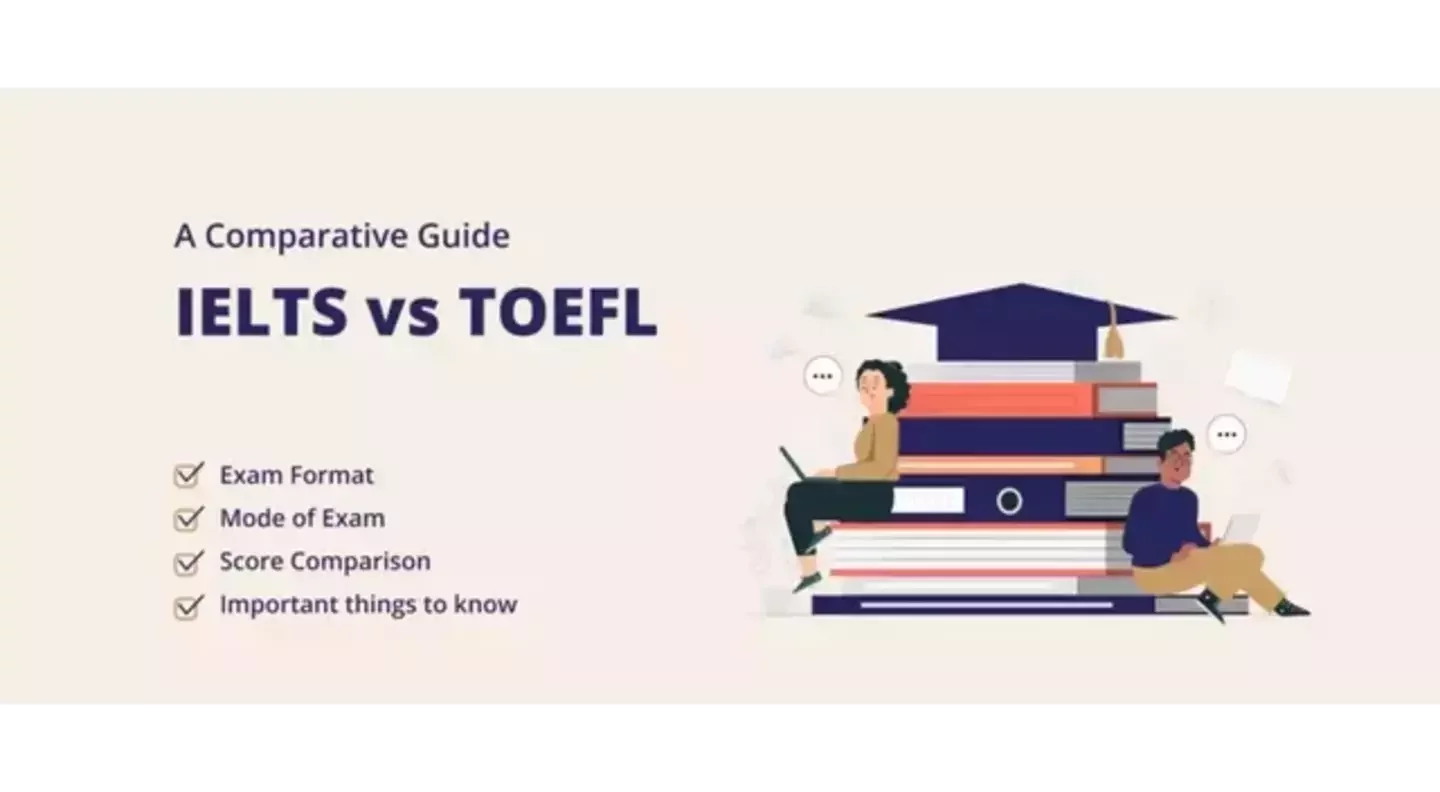Get instant loan offer suitable to your profile !


On this Page:
Confused about whether to take IELTS or TOEFL for your university application? This blog gives a detailed comparison between IELTS and TOEFL, highlighting differences in format, test variations, duration, exam format, modes of exam, and score comparison.
TOEFL-ready? Enjoy INR 2,000 off your application when you register with your trusted i.e. GyanDhan!

To obtain a broad understanding of the distinctions between the two English language exams, a table outlining basic differences between IELTS and TOEFL has been presented below:
| Basis of Difference | IELTS | TOEFL |
|---|---|---|
|
Conducting body |
IDP Education Ltd. |
Educational Testing Services |
|
Test variations |
|
|
|
Test duration |
2 Hours and 45 Minutes |
1 Hour 56 Minutes |
|
Break time |
No breaks. Although, the speaking portion can be taken up to a week before or after the rest of the test. |
5 - 10 minutes break between listening and speaking sections. |
|
Test score range |
0 - 9 |
0 - 120 |
|
Mean of accepted score |
6.3 |
88 |
|
Test frequency in a year |
48 times |
50 times |
|
Result timeline |
13 days after the test |
10 days after the test (result declaration exact date will be notified right after the test) |
|
Allication cost |
16,200 INR (198 USD) |
15,750 INR (190 USD) |
Struggling with Your Admissions?

The format of the IELTS and TOEFL exams differ in a few ways. Below is a comparison of the exam formats:
| Section | IELTS | TOEFL |
|---|---|---|
|
Reading |
|
|
|
Writing |
|
|
|
Listening |
|
|
|
Speaking |
|
|
Although both IELTS and TOEFL are English language proficiency tests, many test takers perceive IELTS as being comparatively easier than TOEFL, primarily due to the reading section. In IELTS, the reading section involves reading excerpts from various sources, such as magazines, books, journals, and newspapers, which are generally easier to comprehend. In contrast, the TOEFL reading section includes excerpts from academic textbooks and publications, which may contain technical vocabulary that can be challenging to understand.
Both exams can be given by the students via different modes available. One needs to select the preferred mode while applying for the test.
TOEFL: The two modes in which TOEFL is conducted are:
 Paper-Based Test (PBT): this is conducted at an offline location where there is no availability of internet. This has three sections - reading, writing, and listening.
Paper-Based Test (PBT): this is conducted at an offline location where there is no availability of internet. This has three sections - reading, writing, and listening.
 Internet-Based Test (iBT): this is an internet-based test that measures individuals against 4 sections that are reading, writing, speaking, and listening. It is the most preferred mode of TOEFL, almost 97% of people prefer this mode. The registration is also made more simplified.
Internet-Based Test (iBT): this is an internet-based test that measures individuals against 4 sections that are reading, writing, speaking, and listening. It is the most preferred mode of TOEFL, almost 97% of people prefer this mode. The registration is also made more simplified.
Note: Educational Testing Services (ETS) has also launched a TOEFL home edition for test takers which can be taken on your own computer from home. It is monitored by a human proctor online.
IELTS: This is also conducted in two modes:
 Computer-Delivered IELTS exam: this was introduced back in 2017 in which you have to type the answers on the boxes provided. For this test, you have to go to the IELTS test centers. The 4 sections that are in this exam are writing, reading, listening, and speaking.
Computer-Delivered IELTS exam: this was introduced back in 2017 in which you have to type the answers on the boxes provided. For this test, you have to go to the IELTS test centers. The 4 sections that are in this exam are writing, reading, listening, and speaking.
 Paper-based IELTS exam: for this test, you will have to write the answers on paper and then submit them to the invigilator.
Paper-based IELTS exam: for this test, you will have to write the answers on paper and then submit them to the invigilator.

Both these exams have a similar type of question that requires objective answers as input. Apart from the writing section that includes writing essays, the entire test consists of objective type of questions. IELTS scores the candidate on a range of 0 - 9 while TOEFL scores the candidate on a score range of 0 - 120. A comparison of their respective scoring system is shown below:
| IELTS Score | TOEFL Score | Score Description |
|---|---|---|
|
9 |
117 - 120 |
Expert user |
|
8 |
110 - 116 |
Very good user |
|
7 |
102 - 109 |
Good user |
|
6 |
94 - 101 |
Competent user |
|
5 |
79 - 93 |
Modest user |
|
4 |
60 - 78 |
Limited user |
|
3 |
46 - 59 |
Extremely limited user |
|
2 |
35 - 45 |
Intermittent user |
|
1 |
32 - 34 |
Non-user |
|
0 |
0 - 31 |
Poor or did not attempt the test |

Test Report Form (TRF) is sent to you by your IELTS test center to your postal address. In case you have given a computer-based test then you can expect the TRF in 3 - 5 days while in case you have given a paper-based test then TRF will be posted to you by 13 days after the exam date. You can also download an online copy of your result by verifying your IELTS result and then clicking the download result option.
You can send your IELTS score to 5 universities within one month of the exam date. The university will receive the scores via e-mail, regular posts, courier, or overseas postage. Beyond these 5, any Additional Test Report Forms (ATRFs) will involve an administrative charge of 250 INR per university via online medium and 1500 INR per university via a physical medium.
Upon completing the test, you will receive a notification with the specific date on which your scores will be released. Additionally, you will receive real-time notifications in the event of any changes to your score status. Your scores will typically be available for viewing on your ETS account approximately 6 days after the test date, with an email notification sent to you upon their availability. Access to your account can be achieved online or through the official TOEFL app. Downloadable PDF score reports will be ready for download within 8 days after your test.
The initial fee that is paid for TOEFL includes the cost of sending the TOEFL test cores to 4 universities that need to be selected by the candidate before. They can change the same till 10:00 PM before the exam day. If you want to send the test results to more than 4 universities then you would need to pay an additional sum of 20 USD per university.
Note: Your TOEFL score is valid for 2 years from the date of the exam.

When it comes to visa process, both IELTS and TOEFL scores are widely recognized by universities and authorities around the world. However, which test is better for visa depends on the country and specific requirements of the visa process.
In general, IELTS is typically preferred for migration to countries such as Canada, Australia, and UK, where it is often a requirement for immigration, work, and study purposes. On the other hand, TOEFL may be more suitable for migration to the US, where it is often required by universities and some employers.
It's important to note that each country visa process has its own specific language requirements, so it's essential to check with the respective authorities which test is suitable for your specific situation.
So IELTS vs TOEFL: Which is better
Check Your Education Loan Eligibility

Ask from a community of 10K+ peers, alumni and experts
Trending Blogs
Similar Blogs

Network with a community of curious students, just like you
Join our community to make connections, find answers and future roommates.. Join our CommunityCountry-Wise Loans
Best Lenders for Education Loan

ICICI Bank

Axis Bank

Union Bank

Prodigy

Auxilo

Credila

IDFC

InCred

MPower

Avanse

SBI

BOB

Poonawalla

Saraswat